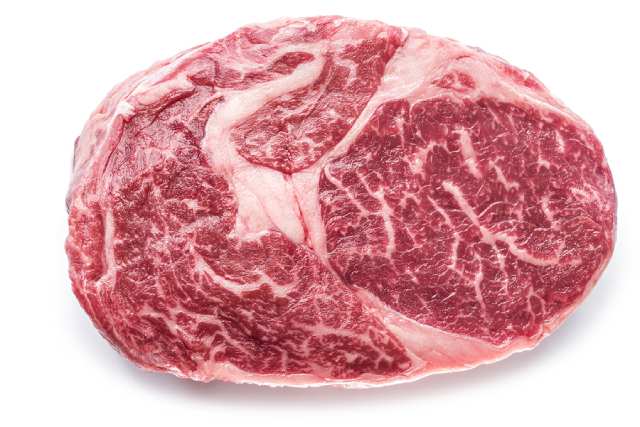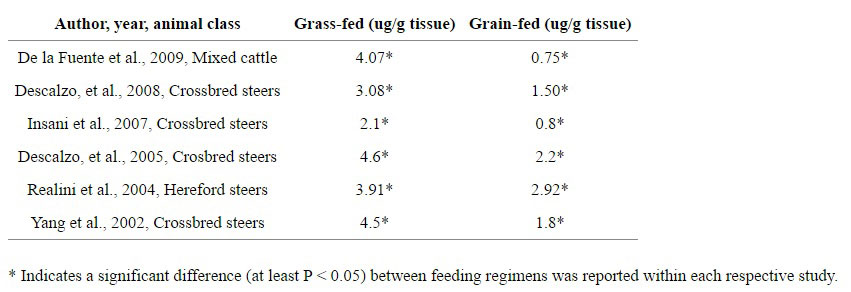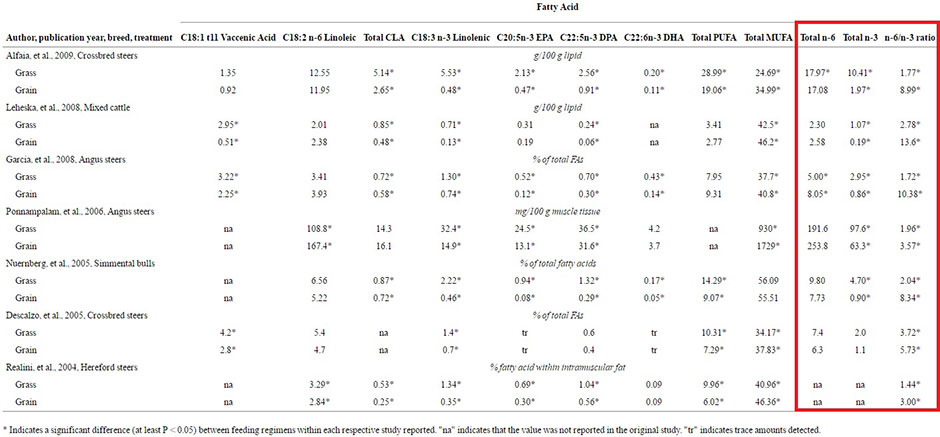Compare Iron Content in Grass Fed Beef Versus Grain Fed Beef
Last Updated on May 8, 2021 by
Demand for grass-fed 'pastured' beef has increased rapidly over the past decade.
It is also common to hear claims that grass-fed beef is healthier, cleaner, and more humane than grain-fed meat.
Still, is it truthful that grass-fed beefiness is nutritionally superior?
This commodity takes a propaganda-free look at the arguments both for and against grass-fed beef.

Note
There are legitimate ecology and creature welfare concerns virtually how beefiness is produced.
That said, these problems are beyond the scope of this article, which will focus solely on the nutritional arguments.
Producing grass-fed and grain-fed beef
First of all, nigh cattle are "grass-fed" for the bulk of their lives.
Co-ordinate to livestock experts at Pennsylvania State University, the vast majority of cows spend the starting time two-thirds of their life feeding on pasture (1).
Nonetheless, at that place are some differences in the mode in which grass-fed and grain-fed beef are produced.
Grass-fed
Pastured cows are primarily raised on a diet of grass, and they will mostly eat hay (stale grass) in the winter (2).
As earlier mentioned, most cattle spend a significant amount of time grazing on pasture, only it is in the last tertiary of their life that some key differences begin to emerge.
For example, many cattle are "grain-finished," which may mean the cows spend the terminal third of their life in a feedlot.
A smaller proportion of cattle spend their entire lifetime grazing on pasture, and beef from these cows may be labeled "100% grass-fed".
Grass-fed beef is relatively common in countries such as Commonwealth of australia, New Zealand, and the U.k..
However, only 4% of cows spend their lives on pasture in the United States, and 96% move to feedlots (3).
Grain-fed
In contrast to grass-fed cattle, grain-fed cows spend the latter portion of their life feeding on grains, often in a feedlot.
The verbal grains used for feed will differ past subcontract and country, simply these grains typically include barley, corn, sorghum, and soy (iv).
These grains are all high-energy feed options, and they result in increased muscle growth and weight gain in the cows.
For this reason, grain-feeding is preferred by many farming operations due to the enhanced efficiency and profitability it offers. Grain-fed beef also represents the majority of beefiness produced within the United States (5).
Key Point: Grass-fed beef comes from cows fed on grass for the majority of their lives. Conversely, grain-fed beef comes from animals that feed on grains during the latter office of their lives.
The bones nutrition profile of grass-fed beef vs. grain-fed beef
All beef is nutritious and an excellent source of poly peptide, vitamins, and minerals.
However, in that location are some small nutritional differences between grass-fed and grain-fed beef.
In the following table, nosotros can come across how grass-fed and grain-fed beef compare nutritionally on a per-100-gram basis.
The respective data is for regular (raw) ground beef, sourced from the USDA'due south FoodData Central database (6, 7).
| Calories/Food | Grass-fed, ground beef | Grain-fed, basis beef |
|---|---|---|
| Calories | 198 kcal | 247 kcal |
| Saccharide | 0 thousand | 0 k |
| Fat | 12.73 thou | 19.07 grand |
| Saturated | 5.34 chiliad | vii.29 g |
| Monounsaturated | 4.80 thou | 8.48 grand |
| Polyunsaturated | 0.53 grand | 0.51 g |
| Protein | nineteen.42 g | 17.44 g |
The to a higher place data provides a general idea of the potential nutritional differences between grass-fed and grain-fed beef.
Generally speaking, the central distinction is that grass-fed beef is leaner than grain-fed beefiness.
However, information technology should exist noted that the precise nutritional values can vary depending upon the feeding regime. For example, the quantity of grains the cows eat and their ability to exercise can both affect the leanness of the beef.
Key Indicate: Grass-fed beef is commonly bacteria than grain-fed.
Nutrients and compounds in beefiness
In that location are also some specific differences between grass-fed and grain-fed in the concentration of nutrients and other compounds that occur in beef.
Conjugated linoleic acid (CLA)
Conjugated linoleic acrid, otherwise known equally CLA, is a natural trans-fatty.
While the "trans-fat' proper noun may describe business organisation, it does not have the same effects every bit bogus trans-fats, and it has neutral/negative associations with cardiovascular disease (viii, 9).
Further, pre-clinical and human trials suggest that CLA may even have a range of beneficial health effects (x).
A contempo systematic review and meta-analysis of clinical trials also demonstrated that CLA supplementation might slightly reduce trunk weight. However, the results were non considered clinically significant (xi).
Ruminal bacteria play a role in the production of CLA, which is why nosotros tin observe CLA in dairy/meat from ruminants (12).
Studies looking at the full CLA content of beef consistently demonstrate that grass-fed beef provides a greater concentration of the fatty acid (thirteen).
Central Point: Grass-fed beefiness contains more than conjugated linoleic acrid than grain-fed beef.
Fatty-soluble vitamins A and Due east
Grass-fed beef is a richer source of the fat-soluble vitamins A and East.
Regarding vitamin A, cows feeding exclusively on grass consume a greater corporeality of carotenoids.
Carotenoids are precursors to provitamin A (retinol), which is the bioavailable form of the vitamin (14).
On this note, studies evidence that beefiness from pasture-fed cattle can accept up to seven times higher carotenoid content than grain-fed beef (15, 16).
Additionally, grass-fed beef contains significantly higher concentrations of vitamin E.
The table below displays the findings of studies that compared the vitamin E content of grass-fed and grain-fed beefiness (17):

As shown from these results, grass-fed beef broadly provided at to the lowest degree twice as much vitamin E as grain-fed beefiness.
Key Indicate: Grass-fed beef has a higher concentration of fatty-soluble vitamins.
Monounsaturated fat content (oleic acid)
The predominant monounsaturated fatty acid in beefiness is oleic acid (18).
For those unaware, oleic acid is besides usually referred to equally the "middle-salubrious" fatty acid in olive oil.
According to the US Food and Drug Administration (FDA), there is"supportive but non conclusive prove"that daily consumption of oleic acrid may reduce the gamble of middle disease (nineteen).
Mainly due to the fact that grass-fed beef is leaner, it contains a smaller corporeality of monounsaturated fat than grain-fed beef. This is because the oleic acid content of beef increases with the amount of marbling.
In this regard, a range of studies demonstrates that grass-fed beef has approximately thirty-lxx% less monounsaturated fat than grain-fed beefiness (twenty).
Key Point: Grain-fed beef typically has a higher fatty content and a greater amount of marbling. For this reason, it is too college in monounsaturated fat.
Omega-3 content
Meat from grass-fed animals contains a college amount of omega-3.
The below data shows the results of six studies investigating the fatty acid profile of both grass-fed and grain-fed beef (21):

As the table shows, grass-fed beef consistently contains a higher amount of omega-iii. Additionally, it has a lower omega-6 to omega-three ratio.
Some researchers believe that the ratio of omega-6 to omega-3 may be important for human health. 1 of the reasons behind this is that traditional human being diets had an omega-6 to omega-3 ratio of around 1:1. In the nowadays 24-hour interval, this ratio is thought to be as loftier as 20:1 in the average Western-style diet (22, 23).
Still, it is worth remembering that beef is not a significant source of either omega-three or omega-half dozen. Beef mainly consists of saturated and monounsaturated fat; information technology contains only 0.5 grams of polyunsaturated fat per 100 grams (v, 6).
Central Point: Grass-fed beefiness has a higher omega-3 content than grain-fed beef.
Taste
Grass-fed and grain-fed beef have a unlike sense of taste, and we can attribute a lot of this to the varying levels of fat and marbling betwixt the 2.
Generally speaking, fattier cuts of beef are more prized, and we tin come across an example of this with Japanese Wagyu.
Wagyu has exceptionally high levels of fat/marbling, and this is a significant cistron in why it tastes good.
In short, many people prefer the gustation of fattier cuts of grain-fed beefiness. This assertion is supported by palatability panel scores that see grain-fed beef significantly outperform grass-fed beefiness (24).
Grass-fed beef may not be equally tender every bit grain-fed beef due to the (typically) lower fat content.
Additionally, grass-fed beefiness tends to take a stronger and "meatier" flavor similar to other leaner meats such as bison and venison.
Key Point: People tend to enjoy the sense of taste of grain-fed beef more than grass-fed.
Is grass-fed or grain-fed beef the better option?
Overall, both grass-fed and grain-fed beef have benefits and drawbacks.
Based solely on the nutrition profile, grass-fed beefiness is slightly superior due to its higher vitamin and CLA content. It is also more protein-dumbo.
Notwithstanding, the differences are only minor, and all types of beef offer proficient nutritional value.
It is besides worth considering the toll; grass-fed beefiness typically costs around 30% more than than grain-fed beefiness.
Affordability and sense of taste preferences are merely every bit relevant as the nutritional profile also. Therefore, the superior pick is the i that best meets the needs of each individual.
For more on meat, see this guide to the benefits and drawbacks of ruddy meat.
Source: https://www.nutritionadvance.com/grass-fed-vs-grain-fed-beef/

0 Response to "Compare Iron Content in Grass Fed Beef Versus Grain Fed Beef"
Post a Comment